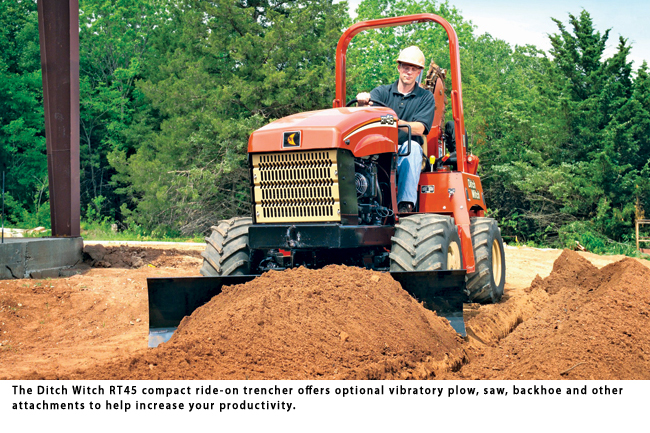Sit Back … It’s Time to Trench
There is no single method or machine suitable for every type of utility installation project. But there are certain jobs when the compact ride-on trencher is definitely the better choice, especially when the task involves digging a hundred feet of utility trench or more in a single workday.
The Association of Equipment Manufacturers (AEM) classifies “compact” ride-on machines based on net engine horsepower. These machines are designed for general contracting work like installing deeper residential utilities such as water, gas, telephone, electric and mainline installations. In my world, the Ditch Witch organization, our 42-hp ride-on RT45 model falls into the category of a compact ride-on machine. The trenching range of ride-on compact machines is generally about six to 12 in. wide and about 3 to 5 ft deep. With this range, a compact ride-on trencher is suitable for a wide variety of water, sewer, gas, electric and telecommunication line installations.

There are many advantages to a compact ride-on model vs. a walk-behind model, the first being the option for the operator to be seated for the better part of the day. Equipment manufacturers understand that a comfortable worker is a more productive worker, which is why operator stations have evolved significantly over the last 10 years. Many ride-on trencher operator stations now feature ample leg room, tilt steering, adjustable armrests and ergonomic, padded seats that can be adjusted for height, slide forward and backward and rotate 90 degrees. Control of trencher functions has also improved, with color-coded controls arranged for easy, natural operation.
On the subject of options, one of the most important advantages of the compact ride-on trencher is its versatility. Most ride-on trenchers in this horsepower range offer a choice of attachments, so you can perform a variety of tasks with one machine. A utility backhoe is one of the most popular attachments. Others are the vibratory plow, combination vibratory plow/offset trencher and hydraulic boring attachment. Medium-range ride-on models can be equipped with attachments to do as many as six different underground jobs.
Many units can even drive two different sizes of trencher attachments as well as a backhoe, rotary saw, vibratory plow and combination trencher/plow. A careful analysis of how a machine is to be used will help you decide whether the extended capabilities offered by attachments will justify the added investment costs.
Mechanical or Hydrostatic?
Equipment buyers have a choice of machines with mechanical or hydrostatic trenching drive systems. Some trencher owners consider mechanical drive systems to be the most productive and believe that hydraulic drives are easier to maintain. Generally speaking, mechanical trenching drives transmit a greater percentage of engine horsepower to the digging component. On the downside, they require belt and chain adjustments and lubrication, and the operator must use a clutch and shift lever to change digging chain speeds.
Hydrostatic machines are generally easier to operate. The operator can adjust digging speeds without shifting gears, and hydrostatic models require less regular maintenance. While maintenance may not seem to be a major factor in choosing a ride-on trencher, consider that the easier a machine is to maintain, the less likely regular service will be neglected. Wear parts must be replaced and regular maintenance and occasional repairs are necessary to keep machines in top running condition. When shopping for a ride-on trencher, it would be wise to look for extended maintenance periods, fewer daily maintenance points and convenient access to service points — all features that make a trencher simpler to maintain and repair.
In recent years, improvements to mechanical and hydrostatic trenching drive systems have narrowed performance differences. Both are efficient and productive, and the choice of which to use has become largely a matter of personal preference.
The Jobsite Influence
The jobsite has a lot to say about which equipment is right for the job. A compact ride-on trencher is a good choice if you’re in a relatively flat, open area and not restricted by established lawns or other sensitive landscaping — a new construction site such as a housing addition, for example. Compact ride-on trenchers are typically rubber-tired models that provide good traction when trenching and maneuvering around the jobsite.
The size of the product to be placed in the ground determines how deep and how wide the trench needs to be, but the type of soil in which you’re trenching is one of the biggest factors in the type of equipment you choose — specifically the type of digging system. Equipping a trencher with the digging assembly, chain and teeth best suited for soil conditions in which it will be working will enhance productivity and eliminate unnecessary wear of digging components and stress on the machine.

There are multiple chain-teeth-sprocket combinations, but there are combinations designed specifically for the type of soil at your jobsite. It helps to have a local dealer who understands soil conditions in the area and knows the digging system that will help your trencher work most efficiently.
Where surface improvements, existing underground utilities and restoration costs make excavation impractical or impossible, trenchless installation techniques — e.g., horizontal directional drilling or pipe bursting — are the better choice. But because many utility construction projects continue to be in open country where these factors are not issues, trenching often is the most efficient and cost-effective method of installing underground cable and pipe. And advancements in design and engineering — power, versatility and operator comfort — have made today’s compact ride-on trenchers capable of greater productivity than ever before.
Matt Collins is a product manager of compact equipment at The Charles Machine Works, manufacturer of Ditch Witch products, based in Perry, Okla.




